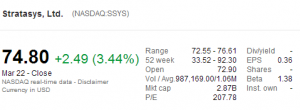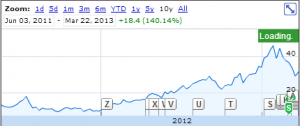All the recent news coverage and developments in additive manufacturing have been a huge boon to the investors in the leading companies. I have written here before about some of this growth but now there is a new player entering the space. ExOne is set to release their first earnings report this Thursday so I decided to take a look at some of the financials of two primary, and publicly traded, competitors. Not only is there an unprecedented amount of projected growth for their primary devices, 3D printers, but these companies are also setup to capitalize on the consumables business created by those printers.
First is Stratasys who has done well over the past few years by making additive manufacturing systems to replace traditional manufacturing methods. From their recent annual report (Page 28): “32% growth due primarily to growth in systems and consumables sales, with service revenue increasing by 12%”.
Printer Unit sales were up less than 2%, but they had a huge shift toward higher priced printers. This sales mix shift is not something you would expect to see if there was a focus on the consumer market, unless the industrial market is growing more rapidly. Stratasys found a customer base that understands the technology and needs feature rich machines. The last paragraph of the same section of their financial report: “As our installed base of systems has increased, the capacity to derive an increasing amount of revenue from sales of consumables, maintenance contracts, and other services has also increased”.
Redeye offers a place where engineers and designers can go to upload a part file and have Stratasys manufacturing it for them for a fee. Of course this manufacturing is done on their 3D printers, using proprietary material both of which are available at wholesale costs. Interestingly this model may allow them huge growth in the future.
Many contract manufacturers offer machining and prototyping services to acquire customers in the pre-production stages. The goal to convert into a production house once the customer requires scale where larger and more stable revenues can be generated. For Statasys this model, as carried out through Redeye, offers a dual path. Either the customer moves into production and Redeye continues to make the parts on a piece cost basis, or the customer can acquire a machine. Of course either of these opportunities leaves Stratasys to provide the materials for the components. The key difference for Statasys is that the materials business is likely their most profitable revenue stream, unlike traditional manufacturing where production orders typically generate the lowest gross margins (when compared to the upfront machining and prototyping services). That is of course if materials are the most profitable cost center, for that I needed to cross reference another financial statement.
3D Systems stock has a similar trend to Stratasys over the past 24 months. In looking at their fanacial statements Page 36 – Table 6 shows gross profit and profit margins for their three published divisions. Maybe because of their crazy pace of acquisitions, or just good management, they have been able to deliver huge growth in both gross profits and profit margins across the company.
 |
| 3DS Sales and Profit Mix |
Looking specifically at their material divisions it is crazy to see they have moved profit margins by from 61.1% to 68.8% over the past three years. Even with the materials division falling from first to last in terms of gross sales (now at 29% of gross sales) the division still maintains the number one spot when it comes to gross profits (38.9% of corporate profits).
ExOne offers machines with a much broader scope of materials including a number of metals and engineering plastics. Each of these materials commands a higher cost on the open market and if ExOne is able to command the type of margins on their materials that 3D Systems can on their lower end plastics it could be a huge benefit to investors. Of course there total installed user base is much smaller, one analyst states they could be on pace to sell 56 total printers in 2013, and the price of the systems is much higher so it may be some time before their materials division really begins to take hold. It’ll be interesting to see how things are shaping up for sure, who knows this could be the beginning of huge growth for ExOne.


